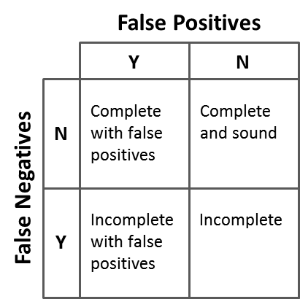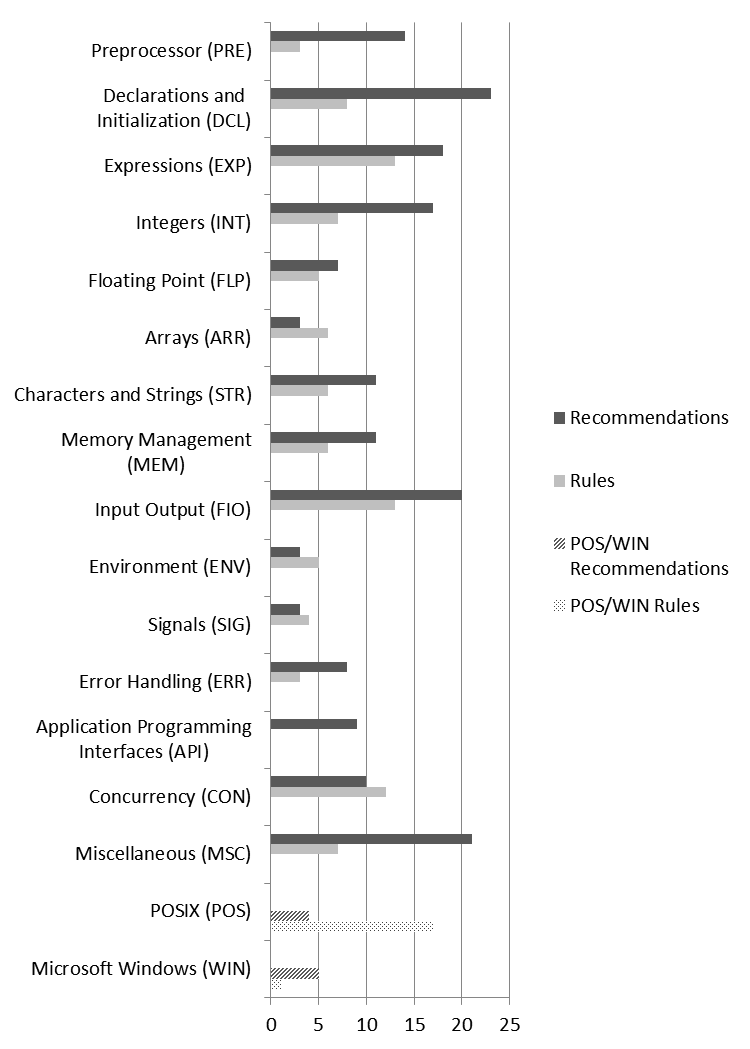Tool Selection and Validation
Although rule checking can be performed manually, with increasing program size and complexity, it rapidly becomes infeasible. For this reason, the use of static analysis tools is recommended.
When choosing a compiler (which should be understood to include the linker), a C-compliant compiler should be used whenever possible. A conforming implementation will produce at least one diagnostic message if a preprocessing translation unit or translation unit contains a violation of any syntax rule or constraint, even if the behavior is also explicitly specified as undefined or implementation-defined. It is also likely that any analyzers you may use assume a C-compliant compiler.
When choosing a source code analysis tool, it is clearly desirable that the tool be able to enforce as many of the recommendations on the wiki as possible. Not all recommendations are enforceable; some are strictly meant to be informative.
Although CERT recommends the use of an ISO/IEC TS 17961–conforming analyzer, the Software Engineering Institute, as a federally funded research and development center (FFRDC), is not in a position to endorse any particular vendor or tool. Vendors are encouraged to develop conforming analyzers, and users of this coding standard are free to evaluate and select whichever analyzers best suit their purposes.
Completeness and Soundness
It should be recognized that, in general, determining conformance to coding rules is computationally undecidable. The precision of static analysis has practical limitations. For example, the halting theorem of computer science states that programs exist in which exact control flow cannot be determined statically. Consequently, any property dependent on control flow—such as halting—may be indeterminate for some programs. A consequence of undecidability is that it may be impossible for any tool to determine statically whether a given rule is satisfied in specific circumstances. The widespread presence of such code may also lead to unexpected results from an analysis tool.
However checking is performed, the analysis may generate
- False negatives: Failure to report a real flaw in the code is usually regarded as the most serious analysis error, as it may leave the user with a false sense of security. Most tools err on the side of caution and consequently generate false positives. However, in some cases, it may be deemed better to report some high-risk flaws and miss others than to overwhelm the user with false positives.
- False positives: The tool reports a flaw when one does not exist. False positives may occur because the code is sufficiently complex that the tool cannot perform a complete analysis. The use of features such as function pointers and libraries may make false positives more likely.
To the greatest extent feasible, an analyzer should be both complete and sound with respect to enforceable rules. An analyzer is considered sound with respect to a specific rule if it cannot give a false-negative result, meaning it finds all violations of a rule within the entire program. An analyzer is considered complete if it cannot issue false-positive results, or false alarms. The possibilities for a given rule are outlined in Table P–2.

Table P–2. False-negative and false-positive possibilities
The degree to which conforming analyzers minimize false-positive diagnostics is a quality-of-implementation issue.
Compilers and source code analysis tools are trusted processes, meaning that a degree of reliance is placed on the output of the tools. Consequently, developers must ensure that this trust is not misplaced. Ideally, trust should be achieved by the tool supplier running appropriate validation tests such as the Secure Coding Validation Suite.
False Positives
Although many rules list common exceptions, it is difficult if not impossible to develop a complete list of exceptions for each guideline. Consequently, it is important that source code comply with the intent of each rule and that tools, to the greatest extent possible, minimize false positives that do not violate the intent of the rule. The degree to which tools minimize false-positive diagnostics is a quality-of-implementation issue.
Taint Analysis
Taint and Tainted Sources
Certain operations and functions have a domain that is a subset of the type domain of their operands or parameters. When the actual values are outside of the defined domain, the result might be undefined or at least unexpected. If the value of an operand or argument may be outside the domain of an operation or function that consumes that value, and the value is derived from any external input to the program (such as a command-line argument, data returned from a system call, or data in shared memory), that value is tainted, and its origin is known as a tainted source. A tainted value is not necessarily known to be out of the domain; rather, it is not known to be in the domain. Only values, and not the operands or arguments, can be tainted; in some cases, the same operand or argument can hold tainted or untainted values along different paths. In this regard, taint is an attribute of a value that is assigned to any value originating from a tainted source.
Restricted Sinks
Operands and arguments whose domain is a subset of the domain described by their types are called restricted sinks. Any pointer arithmetic operation involving an integer operand is a restricted sink for that operand. Certain parameters of certain library functions are restricted sinks because these functions perform address arithmetic with these parameters, or control the allocation of a resource, or pass these parameters on to another restricted sink. All string input parameters to library functions are restricted sinks because it is possible to pass in a character sequence that is not null terminated. The exceptions are strncpy() and strncpy_s(), which explicitly allow the source character sequence not to be null-terminated.
Propagation
Taint is propagated through operations from operands to results unless the operation itself imposes constraints on the value of its result that subsume the constraints imposed by restricted sinks. In addition to operations that propagate the same sort of taint, there are operations that propagate taint of one sort of an operand to taint of a different sort for their results, the most notable example of which is strlen() propagating the taint of its argument with respect to string length to the taint of its return value with respect to range.
Although the exit condition of a loop is not normally considered to be a restricted sink, a loop whose exit condition depends on a tainted value propagates taint to any numeric or pointer variables that are increased or decreased by amounts proportional to the number of iterations of the loop.
Sanitization
To remove the taint from a value, the value must be sanitized to ensure that it is in the defined domain of any restricted sink into which it flows. Sanitization is performed by replacement or termination. In replacement, out-of-domain values are replaced by in-domain values, and processing continues using an in-domain value in place of the original. In termination, the program logic terminates the path of execution when an out-of-domain value is detected, often simply by branching around whatever code would have used the value.
In general, sanitization cannot be recognized exactly using static analysis. Analyzers that perform taint analysis usually provide some extralinguistic mechanism to identify sanitizing functions that sanitize an argument (passed by address) in place, return a sanitized version of an argument, or return a status code indicating whether the argument is in the required domain. Because such extralinguistic mechanisms are outside the scope of this book, we use a set of rudimentary definitions of sanitization that is likely to recognize real sanitization but might cause nonsanitizing or ineffectively sanitizing code to be misconstrued as sanitizing. The following definition of sanitization presupposes that the analysis is in some way maintaining a set of constraints on each value encountered as the simulated execution progresses: a given path through the code sanitizes a value with respect to a given restricted sink if it restricts the range of that value to a subset of the defined domain of the restricted sink type. For example, sanitization of signed integers with respect to an array index operation must restrict the range of that integer value to numbers between zero and the size of the array minus one.
This description is suitable for numeric values, but sanitization of strings with respect to content is more difficult to recognize in a general way.
Rules versus Recommendations
This book contains 98 coding rules. The CERT Coding Standards wiki also has 178 recommendations at the time of writing. Rules are meant to provide normative requirements for code, whereas recommendations are meant to provide guidance that, when followed, should improve the safety, reliability, and security of software systems. However, a violation of a recommendation does not necessarily indicate the presence of a defect in the code.
Rules and recommendations are collectively referred to as guidelines. Rules must meet the following criteria:
- Violation of the guideline is likely to result in a defect that may adversely affect the safety, reliability, or security of a system, for example, by introducing a security flaw that may result in an exploitable vulnerability.
- The guideline does not rely on source code annotations or assumptions of programmer intent.
- Conformance to the guideline can be determined through automated analysis (either static or dynamic), formal methods, or manual inspection techniques.
Recommendations are suggestions for improving code quality. Guidelines are defined to be recommendations when all of the following conditions are met:
- Application of a guideline is likely to improve the safety, reliability, or security of software systems.
- One or more of the requirements necessary for a guideline to be considered a rule cannot be met.
FIGURE P–1 shows how the 98 rules and 178 recommendations are organized.

FIGURE P-1. CERT C coding guidelines
The wiki also contains two platform-specific annexes, one for POSIX and one for Windows, which have been omitted from this book because they are not part of the core standard.
The set of recommendations that a particular development effort adopts depends on the requirements of the final software product. Projects with stricter requirements may decide to dedicate more resources to ensuring the safety, reliability, and security of a system and consequently are likely to adopt a broader set of recommendations.